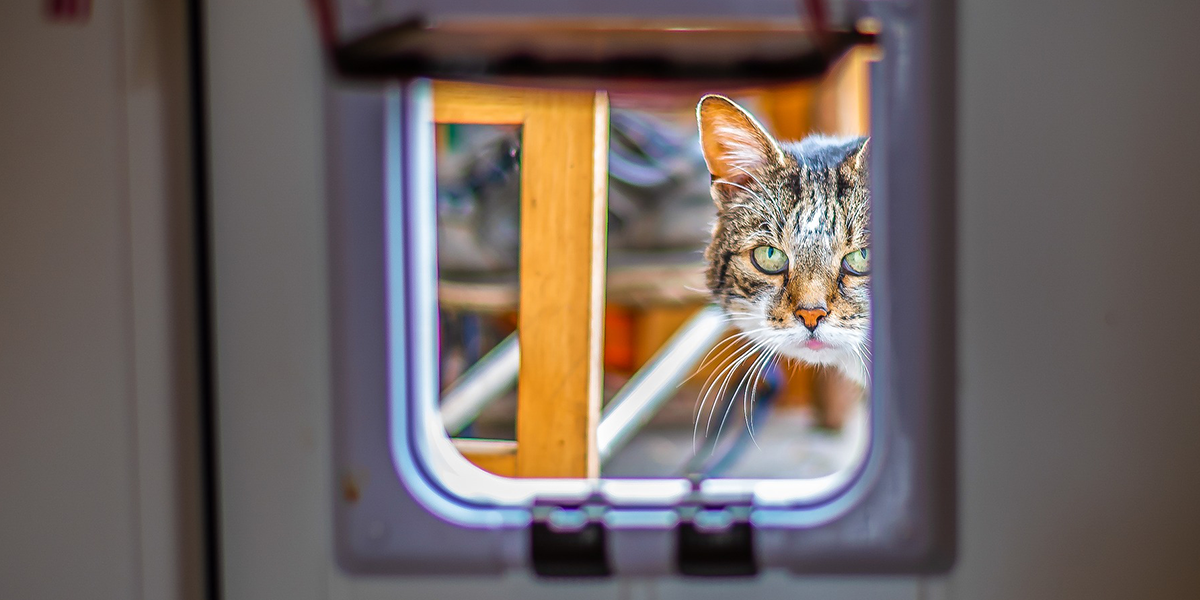How to choose and use a cat flap/door
A cat flap (cat door) enables your cat to come and go through its own door to the great outdoors.
Modern cat flaps of varying designs have features that allow you to adjust the access available, for example locking it at night or allowing ‘in’ only usage after a certain time of day or night. They are manufactured in varying sizes, some even accommodating dogs, and can now be fitted to non-standard doors, such as double-glazed units.
In theory, it sounds like a great idea; you are out and your cat is free to choose where it goes. Cats need to maintain a sense of control over their activity and this provides them with this ability. However, when a cat flap is fitted it may also allow invading cats to take advantage of the breach in defences and steal your cat’s food. Any owner will recognise the way cats stare at a cat flap, spend ages looking through it before they leave or jump when the wind catches it.
Controlling who comes through the flap
To minimise the risk of other cats entering your home it is possible to purchase flaps that offer the resident cats a degree of exclusivity of entry. Magnetic keys can be located on a collar that unlocks the flap but these rely on the cat not losing the collar and that no other cat in the neighbourhood has a replica of the same magnetic key for their own flap that would unlock both. The process of disconnecting the locking mechanism also takes a few seconds so hitting the flap at a run, with an adversary in hot pursuit, is like hitting a brick wall. Once your cat unlocks the flap and gets indoors there is no guarantee that the other cat won’t get in right behind it. Modern exclusive entry cat flaps now work by reading the individual’s microchip under the skin on the back of its neck that is placed there for identification purposes and the unlocking process is faster.
If you are introducing a new kitten to a cat flap, and you already have a resident cat using it with ease, then you will probably need to do nothing in the way of training. Cats learn very quickly by observation, and the kitten will have watched the other cat coming and going out and will have let its curiosity get the better of it. Indeed, if you have a bright, confident kitten you’ll probably need to make sure that it doesn’t go outside before you are ready!
Learning to use the cat door
However, if your cat or kitten hasn’t met with a flap before, you will have to show it the basics. Initially, the clunk and snap of the flap as it shuts can be rather frightening, as can the door as it touches the cat’s back on the way through, with the added fear that its tail will get caught in the flap. Going through is probably a bit like snorkelling for the first time – the difference between being above water and below water is stark and the world suddenly changes beyond recognition. For a kitten, the first exit into the great outdoors is probably pretty scary too.
The best way to get the kitten to investigate is to cut the process into smaller chunks. Prop the door open with a stick or pencil or secure it with adhesive tape so that the door is as wide open as possible and won’t touch your kitten’s back when it goes through. You might want to carry the kitten outside and let it go through the flap in the direction of indoors first so that it’s going into a familiar environment rather than heading into something completely alien. Get someone on the inside to encourage your kitten or cat through and reward it with a treat when it arrives. Then gradually prop the door a little less widely open and let the kitten go through it until it’s pushing the door a little and getting used to the sensation. If you want to lock the flap to keep the kitten inside sometimes, put a visual signal there for it, such as a piece of board, so that it’s not confused by the flap not budging when it pushes.
Thank you for visiting our website, we hope you have found our information useful.
All our advice is freely accessible to everyone, wherever you are in the world. However, as a charity, we need your support to enable us to keep delivering high quality and up to date information for everyone. Please consider making a contribution, big or small, to keep our content free, accurate and relevant.
Support International Cat Care from as little £3
Thank you.
Donate Now


